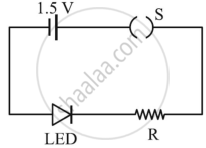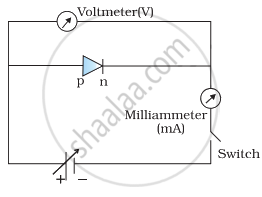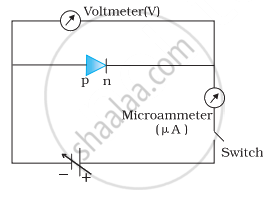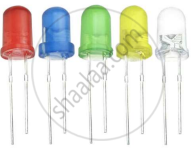Advertisements
Advertisements
प्रश्न
Read the following paragraph and answer the questions.
|
LED is a heavily doped P-N junction which under forward bias emits spontaneous radiation. When it is forward-biased, due to recombination of holes and electrons at the junction, energy is released in the form of photons. In the case of Si and Ge diode, the energy released in recombination lies in the infrared region. LEDs that can emit red, yellow, orange, green and blue light are commercially available. The semiconductor used for fabrication of visible LEDs must at least have a band gap of 1.8 eV. The compound semiconductor Gallium Arsenide – Phosphide is used for making LEDs of different colours.
|
- Why are LEDs made of compound semiconductor and not of elemental semiconductors?
- What should be the order of bandgap of an LED, if it is required to emit light in the visible range?
- A student connects the blue coloured LED as shown in the figure. The LED did not glow when switch S is closed. Explain why?

OR
iii. Draw V-I characteristic of a p-n junction diode in
(i) forward bias and (ii) reverse bias
उत्तर
- LEDs are made up of compound semiconductors and not by the elemental conductor because the band gap in the elemental conductor has a value that can detect the light of a wavelength which lies in the infrared (IR) region.
- 1.8 eV to 3 eV
- LED is reversed-biased that is why it is not glowing.
OR
iii. (i) forward bias -

(ii) reverse bias

APPEARS IN
संबंधित प्रश्न
With what considerations in view, a photodiode is fabricated? State its working with the help of a suitable diagram.
Even though the current in the forward bias is known to be more than in the reverse bias, yet the photodiode works in reverse bias. What is the reason?
Describe, with the help of a circuit diagram, the working of a photodiode.
Draw V − I characteristics of a p-n junction diode. Answer the following questions, giving reasons:
(i) Why is the current under reverse bias almost independent of the applied potential up to a critical voltage?
(ii) Why does the reverse current show a sudden increase at the critical voltage?
Name any semiconductor device which operates under the reverse bias in the breakdown region.
Explain the formation of depletion layer and potential barrier in a p−n junction.
Draw the circuit arrangement for studying the V-I characteristics of a p-n junction diode in reverse bias. Plot the V-I characteristics in this case.
Draw the V-I characteristics of an LED. State two advantages of LED lamps over convertional incandescent lamps.
What is a solar cell?
Briefly explain how emf is generated in a solar cell.
How can a photodiode be used to measure light intensity?
What energy conversion takes place in a solar cell?

